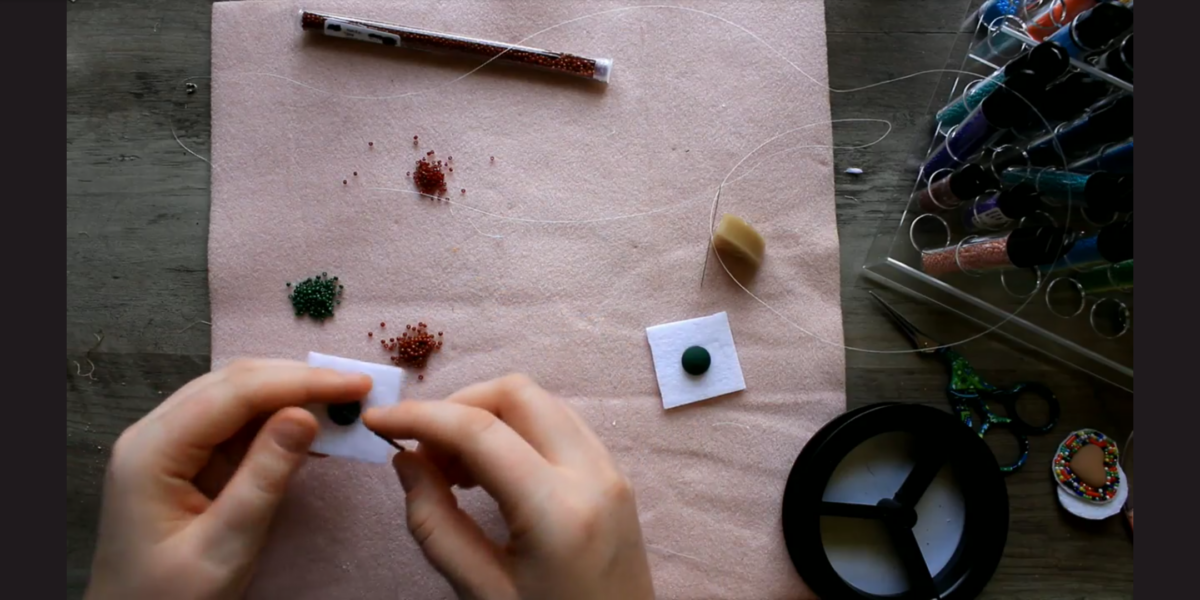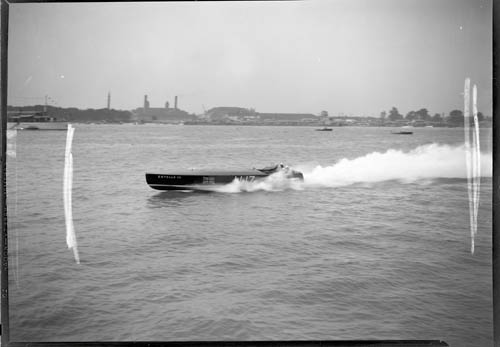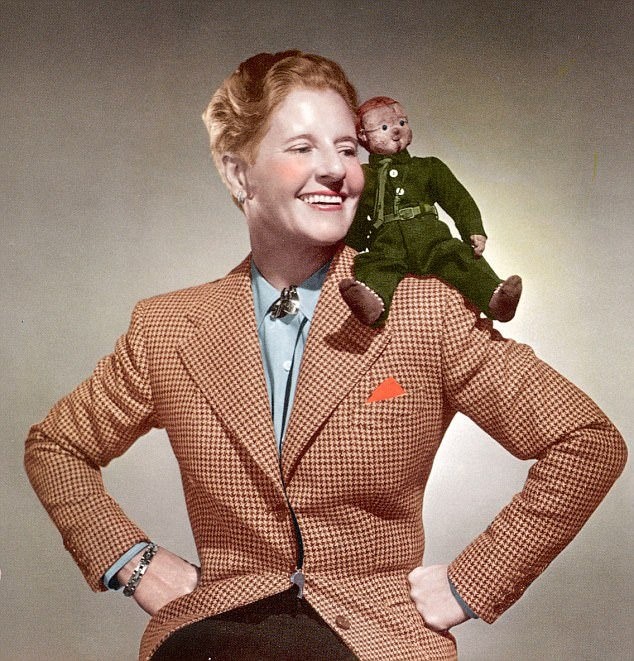How My Internship at Mystic Seaport Museum Brought Me Closer to My Tribe’s Beading Heritage
By Cheyenne Morning Song Tracy, White Earth Anishinaabe (Ojibwe)

I was born in New London, raised in Groton, and have been coming to Mystic Seaport Museum since I was three. It’s always been a special place for me, so when I heard of the Museum’s internship program that was centered on the theme of Reimagining New England Histories, with the goal of including diverse narratives in the museum, I jumped at the chance to be involved. As a Native American woman, I have rarely seen this done, and I felt that this was something that I needed to be a part of. The experience has been far more impactful than I could have realized. During the internship, I had the opportunity to work with a Mystic Seaport Museum community partner, Tomaquag Museum in Exeter, Rhode Island. This museum is a Native American-run space that does not have specific ties to any one tribe. The Tomaquag Museum tells a cohesive story of the local tribes of New England. Unfortunately, due to a lack of funding and staffing, their collection hadn’t been inventoried in over 40 years. During the summer, my intern team and I were able to inventory their entire collection of belongings (The term belonging is used when describing artifacts in a collection to acknowledge personal connection of the people and communities who created and cared for them.
While doing this inventory, I was able to experience many amazing belongings. Working in a small room I got to know the beadwork intimately. Though not alive, the presence of the beaders that had stitched and worn the beadwork was still there. The beadwork has a life of its own, it opens a window into the thoughts and feelings of the beader. With every box I took off the shelves, opening and unwrapping the beadwork, I always felt my heartbeat get a little faster. While reflecting on this experience, I realized that the beaded makizin (Anishinaabek for moccasins) that I worked with were the first I had handled that were not mass-produced. While wearing protective gloves to prevent oils from my skin from getting onto the beadwork, I would run my hand over the beads softly, admiring their craftsmanship and how the beads caught the light and reflected patterns. The buckskin that these moccasins were made out of was almost always dried out from age, and the horsewoman in me wanted to use saddle soap to rehydrate them (though that would not have been a good idea). With the contribution of my research to accompany these belongings, I hope the presence of these past beaders can shine through all the brighter.
As I inventoried the belongings, I felt a strong connection to the beadwork of the northeastern coastal tribes; although I am an Anishinaabe of the White Earth reservation in Minnesota. Minnesota is referred to as the land of ten thousand lakes, and while over 5,000 miles from the Atlantic Ocean, the people have their own connection to water and waterways. My grandmother was raised by her grandparents and grew up on our reservation near Elbow Lake. Her grandparents raised her after her mother died at a young age from tuberculosis. They taught her the traditional ways of their ancestors. This included learning the language, making her a fluent speaker of Anishinaabek. (A note to the reader: Anishinaabe, Anishinaaba, and Anishinaabek are used interchangeably for the tribe depending on the region. Generally Anishinaabek is used in reference to the language). At the age of eight, her father moved her off the reservation causing her to lose much of her knowledge about our language and culture. Because of this, my mom and I did not get the chance to connect to the reservation or our heritage in the same way my grandmother was able to. My grandmother was never taught beadwork, so I was never able to learn beading from her or my mother, the traditional way of learning to bead. The year before my internship at Mystic Seaport Museum I bought an earring beading kit from another Native beader and began my own beadwork journey to connect with my Anishinaabe heritage.
During the first part of my internship, we were encouraged to go to the Educational Powwow at the Mashantucket Pequot Museum and Research Center. Going to this powwow allowed me to see more contemporary beadwork that people were wearing. This is how I met a Shinnecock beader. We struck up a conversation over the beadwork that she had for sale and was working on. I am known by many to be a very shy person, but my ancestors must have given me some courage that day. Talking with her I told her about how I was learning to bead but was not very good. And she encouraged me to keep beading. Through beading, I made a new friend.
Gratefully, after the summer internship at Mystic Seaport Museum concluded, I was able to extend my work through the fall to work more with the beadwork at the Tomaquag Museum. My research was originally focused on what in the collection are Anishinaabe belongings or belongings inspired by Anishinaabe art and tools. My first step was to make a list of what I thought was or could be connected to one of these two categories. As I researched, I realized that what I knew most about and was connected to the deepest was the beadwork. In order to truly understand the difference between Anishinaabe beadwork and other tribes’ beadwork I needed to research the unique characteristics of each. The Anishinaabe are known for floral beadwork designs. As I studied and researched this beadwork, I observed that Anishinaabe traditional beadwork is fluid, circular, and flows, with lots of vines that were often made with opaque white beads. It is often stitched on black or red velvet, and occasionally on a mixture of buckskin and velvet. Flowers tend to be outlined in a different color than the flowers themselves. The petals tend to be oval in shape, and the beadwork is balanced but not mirrored and has S-curve motifs. The Anishinaabe are a woodland tribe. Though different from the woodland tribes of Connecticut and Rhode Island, the Anishinaabe share the use of floral patterns in their beadwork.

Beadwork from the tribes in Connecticut and Rhode Island is different from Anishinaabe beadwork, as it incorporates wampum as well as the pan-Indian style of beading. Wampum are purple and white beads made out of the quahog (hard shell) clam. Traditionally these beads were used as gifts and to document agreements. Wampum belts are highly prized. When the Dutch arrived on Turtle Island (Turtle Island, the Native American name for North America, comes from the creation story about North America being on the back of a turtle.) they saw how prized wampum were and soon started to use it as currency, though wampum is not a currency in Native American culture. Coming into its own in the early 1900s, pan-Indian beadwork is a cohesive style that incorporates the styles of tribes across the United States in distinctive more geometric and western-themed depictions.

Beading existed on Turtle Island long before the arrival of Europeans but this arrival marked a big change in beadwork. Before Europeans, beads were made out of seeds, animal bones, animal teeth, shells, and stones. The Anishinaabe are still renowned for the use of the natural material of porcupine quills. With European arrival came glass seed beads from Italy which brought a variety of colors to the beadwork of Native Americans. This portion of Native American beading history was discussed in Sargent, Whistler and Venetian Glass which closed on February 27. The beaded top hat embellished with wampum pictured below was on loan from the Tomaquag Museum. Also on loan was a necklace constructed from wampum and beads. These belongings are modern so color usage and style are different from older beadwork pieces. Historically, the harder the color was to achieve the more valuable the bead was. The value of beads would also change from tribe to tribe as different tribes valued different colors. But across all tribes, the color that was highly prized was sky blue as it was not something that was achievable in dyes that were available on Turtle Island.


When I first started beading I was making earrings either fringe or powwow style. Beading anything but earrings was intimidating to me as it was so much more time and work. This feeling changed when working with the beadwork at Tomaquag. To feel them, to see them up close, I was inspired by the familiarity of these new beading techniques. Fringe requires only one needle, beads, and thread. While powwow style earrings require the two-needle method, where one thread holds the beads and the other tacks them down onto the backing every two or three beads. The two-needle method is used on larger pieces of beadwork for intricate designs. While the two-needle method sounds more complicated it is in fact just as easy as the fringe earrings. The process of making both these styles of earrings is different, but both are equally important to Native American culture. Another method, one I have yet to try, called lazy or lain stitch is used to cover a larger piece, like makizin, at a faster rate. To do this the beads are stitched down every seven to eight beads in line. There is also loom beading which requires a special loom to weave the beads into one piece. This can be used to make necklaces, bracelets, and lines of beadwork that can be attached to clothes. While there are many other styles of beadwork as well, the ones that I have studied at Tomaquag are lazy/lain stitch, two-needle, and loom beading. The different styles of beading can be overwhelming, but they each are used to achieve a different goal in a beader’s work.

As the summer progressed, I gained more confidence. I never imagined I would attempt to stitch a larger floral beaded design. These are what many imagine when they think of Anishinabek beading. I created the floral work you see in the image for the shoulder pad of a bag for my fiance, my biggest cheerleader. As he saw me growing, he made me a larger bead loom so I could create larger beadwork. I decided I wanted to make a belt. I used a pattern from Beads To Buckskins Volume Two by Peggy Sue Henry. This pattern is in the pan-Indian style, but the colors are inspired by my Anishinabek heritage.
For a long time, I have wanted to bead a pair of makizins that belonged to my grandmother. After her passing in 2012 from cancer I was given her makizins (we both had big feet and I am the only one in the family they fit). While they were not handmade, they belonged to my grandmother and still hold a great connection to her. I think of her when I wear them. Before the work I did at Tomaquag, I was nervous about doing anything with her makizins, as I felt I didn’t know the first thing about beading them. When working with all the beautifully decorated makizins at Tomaquag it was clear, I had to learn to bead my grandmother’s makizins. After nearly a year on this challenging journey, today, when I hold the pair of moccasins from my grandmother, and I eye the blank canvas of the empty hide on top yearning for color and light … I have a feeling I might be ready.
I am so grateful for all that I was able to learn and want to say a big miigwetch (Thank you) to the staff at Mystic Seaport Museum, the staff at Tomaquag Museum, and of course my supportive fiancé.

Visit Cheyenne’s art online at Morning Song Beading.
Bibliography
Barkwell, Lawrence J. “Characteristics of Metis Beadwork.” The Virtual Museum of Métis History and Culture, September 11, 2013. https://www.metismuseum.ca/.
“Beadwork.” Crafting Idaho, 2012. https://crafting.idahohistory.org/beadwork/.
D’Alleva, Anne. Native American Arts & Cultures. Davis Arts & Cultures Series. Worcester, Mass.: Davis Publications, 1993.
Dean, David. Beading in the Native American Tradition. Interweave Press. Loveland, Colorado, 2002.
Densmore, Frances. Chippewa Customs, 1929.
Henry, Peggy Sue. Beads To Buckskins: Volume Two. Jayhwak Tock and FurShop. Hill City, Kansas, 1989.
Smith, Monte and Michele VanSickle. Traditional Indian Beading and Leather Crafts. Eagle’s View Publishing. Liberty, UT.
Thao, Susan. “Worn Within: What is the difference between Dakota & Ojibwe beadwork?” TPT Originals. 2021.




